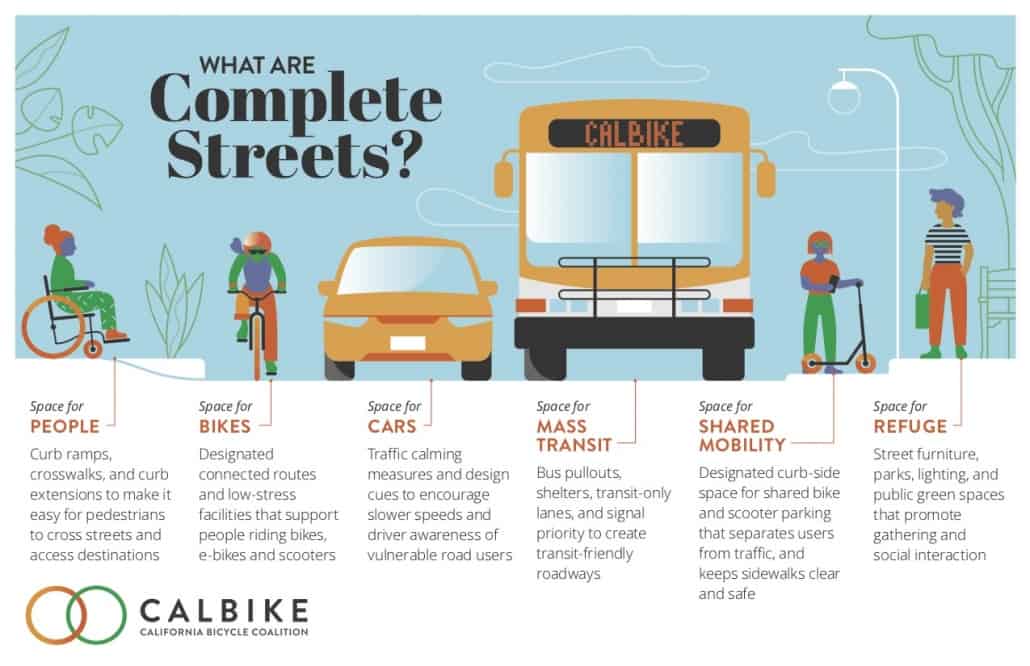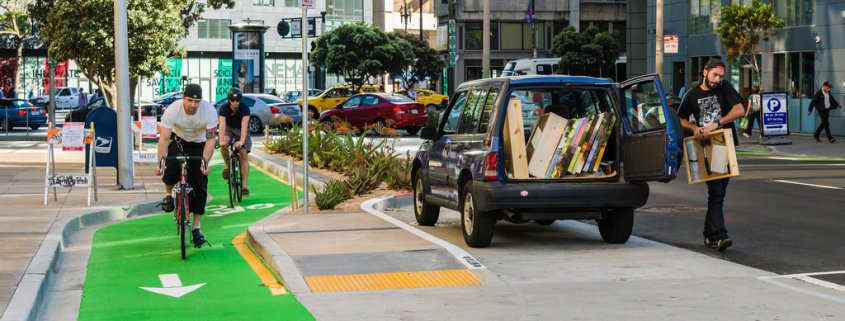The Long Road to Complete Streets
CalBike has been fighting for Complete Streets for more than 15 years. In 2008, we helped pass AB 1358, which required local and regional general plans to consider the safety of people biking and walking in their circulation elements. But that law did nothing to improve access on state routes that doubled as local streets, which are often the most dangerous roadways in a community. So we took the fight to Caltrans.
Over the years, our work to promote Complete Streets on state-controlled roads has been both rewarding and frustrating. Our campaign has scored some critical wins and heartbreaking losses. Recent events have made it clear that Caltrans continues to push transportation funding toward projects that increase traffic and congestion and underfund Complete Streets improvements.
Complete Streets will be a central part of CalBike’s legislative agenda in 2024. So, we thought this would be a good time to revisit the history, evolution, and future of Complete Streets.
What are Complete Streets?
A Complete Street includes elements that make travel safer for people using all modes, including biking, walking, public transit, and automobiles. Complete Streets elements can include:
- Bulbouts to reduce crossing distance for pedestrians
- Crosswalks at frequent intervals, including mid-block crossings, if needed
- Protected bike lanes
- Protected intersections
- Bus-only lanes
- Bus boarding islands
- Narrow traffic lanes, speed humps, chicanes, or other features to reduce driving speeds.
In addition, we must expand the definition of a Complete Street to one where people of all identities and bodies are safe from police harassment. Strategies to accomplish this include decriminalizing biking, walking, and transit use.

Unfortunately, the term Complete Streets has been used at the state level to refer to any element of a project that benefits people biking or walking, including legal requirements such as ADA improvements, rather than the comprehensive vision that Complete Streets is supposed to embody. So, rather than evaluating whether a segment of a state-controlled street can receive all the upgrades needed to make it safe to bike, walk, and board transit, a Caltrans project might include one or a few elements that fall under the heading of “Complete Streets.”
While this approach can improve safety incrementally, it might not make the roadway comfortable or appealing for people biking or walking. It’s analogous to building a bridge halfway across a shark-infested waterway. Is half a bridge better than nothing if it doesn’t get you where you need to go? And, in the worst cases, piecemeal safety improvements can lure people biking or walking into danger. For example, a bikeway that ends abruptly or includes hazardous intersections may encourage people to ride, only to find themselves dumped into dangerous traffic.
Past Complete Streets legislation
In 2017, Senator Scott Wiener introduced SB 760, which would have created a Division of Active Transportation within Caltrans and required the agency to add Complete Streets elements to state routes that were also local streets.
SB 760 didn’t make it into law, but Wiener authored another bill in 2019, SB 127, the Complete Streets Bill. This new bill didn’t create a separate division at Caltrans, but it required the agency to consider adding Complete Streets elements whenever it planned a repaving project. CalBike and our allies and supporters campaigned hard for the Complete Streets Bill and got it through the legislature with high hopes the governor would sign it.
But Governor Gavin Newsom vetoed the Complete Streets bill, saying it was unnecessary because Caltrans already had a Complete Streets policy and didn’t need legislation to build Complete Streets. Four years after that veto, CalBike is surveying people around California and reviewing Caltrans records to learn whether the governor was right.
Caltrans progress on Complete Streets
At the time Governor Newsom vetoed the Complete Streets Bill, Caltrans had a new leader, Toks Omishakin, who took Complete Streets seriously, overseeing a $100 million set aside in the State Highway Operation and Protection Program (SHOPP) budget for Complete Streets elements.
In 2021, Caltrans significantly improved its internal Complete Streets policy (DP-37). Specifically, it directed that “all transportation projects funded or overseen by Caltrans will provide comfortable, convenient, and connected complete streets facilities for people walking, biking, and taking transit or passenger rail unless an exception is documented and approved.” However, without codifying this internal policy into state law, the improvement is divorced from any real accountability.
In 2022, the agency developed two implementation tools to honor its ambitious changes. Caltrans District-wide Active Transportation Plans (CAT Plans) chartered the course for district change, while headquarters released its Complete Streets Action Plan to track its progress.
Out of these efforts, Caltrans implemented a Complete Streets review process for its projects to evaluate whether a road segment includes people biking and walking and, if it does, what Complete Streets improvements could be included in the project. However, this process lacks one thing the Complete Streets Bill would have mandated: transparency. The bill would have required Caltrans to justify its decision when it didn’t include Complete Streets features and to hold a public hearing. Instead, Caltrans buries its process in long and complex documents that aren’t publicly available.
What’s next for Complete Streets
CalBike made a public records request and has received several hundred Caltrans planning documents that include Complete Streets decision forms. We’re reviewing them to understand the trends at the agency and whether it’s acting in the best interests of the citizens of California to make active transportation safer and more accessible. We also conducted a statewide survey to get feedback on the safety of state routes from people who bike and walk on them. We expect to share our data over the next few months as part of a renewed Complete Streets Campaign.
We are also working with legislative champions and our allies to introduce real mandates and accountability. We appreciate our elected leaders who continue to prioritize making our fastest roadways safe for people who get around by bike or on foot.
Caltrans was originally the Department of Highways, and changing the culture of freeway-building that’s ingrained at the agency is not quick or easy. It is, however, imperative. Recently, scientists warned that we have just six years before the Earth reaches the 1.5 degrees Celsius of warming considered to be the threshold we shouldn’t pass.
We must change our transportation patterns now if we’re serious about combating climate change. And that means changing California’s department of highways, freeway-building, smog creation, and traffic inducement into the department of low- and no-carbon transportation, active mobility, public transportation, connection, health, and joy. At CalBike, we’re pushing hard to make that transition a reality.





